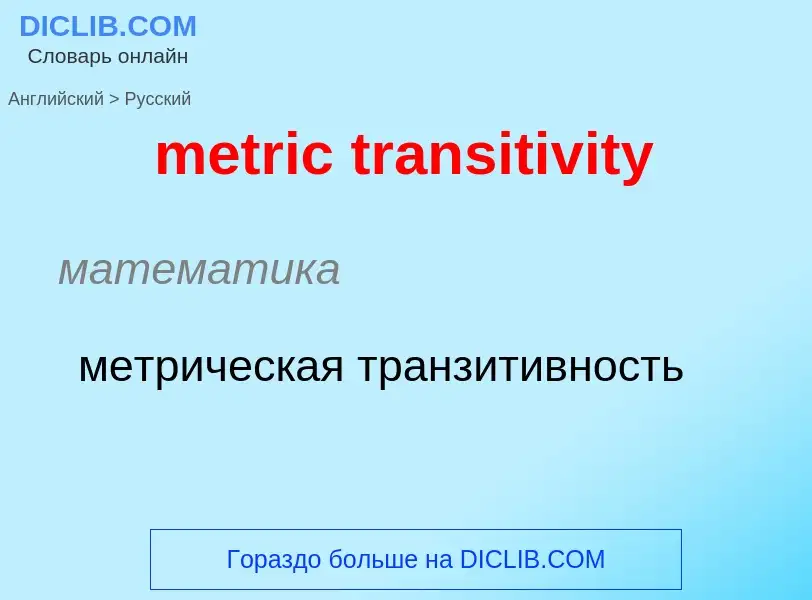Перевод и анализ слов искусственным интеллектом ChatGPT
На этой странице Вы можете получить подробный анализ слова или словосочетания, произведенный с помощью лучшей на сегодняшний день технологии искусственного интеллекта:
- как употребляется слово
- частота употребления
- используется оно чаще в устной или письменной речи
- варианты перевода слова
- примеры употребления (несколько фраз с переводом)
- этимология
metric transitivity - перевод на русский
математика
метрическая транзитивность
общая лексика
десятичная/метрическая система мер
метрическая система
Определение
Википедия
Ergodic theory (Greek: ἔργον ergon "work", ὁδός hodos "way") is a branch of mathematics that studies statistical properties of deterministic dynamical systems; it is the study of ergodicity. In this context, statistical properties means properties which are expressed through the behavior of time averages of various functions along trajectories of dynamical systems. The notion of deterministic dynamical systems assumes that the equations determining the dynamics do not contain any random perturbations, noise, etc. Thus, the statistics with which we are concerned are properties of the dynamics.
Ergodic theory, like probability theory, is based on general notions of measure theory. Its initial development was motivated by problems of statistical physics.
A central concern of ergodic theory is the behavior of a dynamical system when it is allowed to run for a long time. The first result in this direction is the Poincaré recurrence theorem, which claims that almost all points in any subset of the phase space eventually revisit the set. Systems for which the Poincaré recurrence theorem holds are conservative systems; thus all ergodic systems are conservative.
More precise information is provided by various ergodic theorems which assert that, under certain conditions, the time average of a function along the trajectories exists almost everywhere and is related to the space average. Two of the most important theorems are those of Birkhoff (1931) and von Neumann which assert the existence of a time average along each trajectory. For the special class of ergodic systems, this time average is the same for almost all initial points: statistically speaking, the system that evolves for a long time "forgets" its initial state. Stronger properties, such as mixing and equidistribution, have also been extensively studied.
The problem of metric classification of systems is another important part of the abstract ergodic theory. An outstanding role in ergodic theory and its applications to stochastic processes is played by the various notions of entropy for dynamical systems.
The concepts of ergodicity and the ergodic hypothesis are central to applications of ergodic theory. The underlying idea is that for certain systems the time average of their properties is equal to the average over the entire space. Applications of ergodic theory to other parts of mathematics usually involve establishing ergodicity properties for systems of special kind. In geometry, methods of ergodic theory have been used to study the geodesic flow on Riemannian manifolds, starting with the results of Eberhard Hopf for Riemann surfaces of negative curvature. Markov chains form a common context for applications in probability theory. Ergodic theory has fruitful connections with harmonic analysis, Lie theory (representation theory, lattices in algebraic groups), and number theory (the theory of diophantine approximations, L-functions).


![[[Pavillon de Breteuil]], Saint-Cloud, France, the home of the metric system since 1875 [[Pavillon de Breteuil]], Saint-Cloud, France, the home of the metric system since 1875](https://commons.wikimedia.org/wiki/Special:FilePath/BIPM courtyard.jpg?width=200)
![[[James Clerk Maxwell]] played a major role in developing the concept of a coherent CGS system and in extending the metric system to include electrical units. [[James Clerk Maxwell]] played a major role in developing the concept of a coherent CGS system and in extending the metric system to include electrical units.](https://commons.wikimedia.org/wiki/Special:FilePath/James Clerk Maxwell.jpg?width=200)
